Traveling in 2025 isn’t just about packing clothes and remembering your passport; it’s about staying connected. Think about it: flight tickets, hotel bookings, language apps, digital maps, even payments are tied to a power bank in your pocket. But what happens when that device runs out of juice at the worst possible moment?
I’ve been there. Once, while landing in Rome, I had less than 5% left and no paper directions. Finding my accommodation turned into a stressful hunt through crowded streets. Since then, I’ve made one rule for every trip: always carry a dependable portable power source.
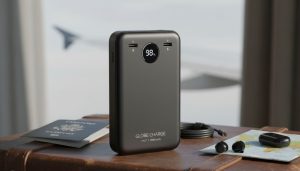
In this article, I’ll share everything I’ve learned about choosing the best power banks for travel in 2025, breaking down airline rules, capacity tips, safety habits, and of course, my top product picks. By the end, you’ll know exactly which type fits your lifestyle and why it deserves a spot in your bag.
What This Power Bank Guide Covers
Here’s a quick roadmap of what you’ll discover:
- Current airline restrictions on portable energy packs
- How to easily calculate battery ratings without stress
- Which size works best for weekend trips versus long-haul adventures
- Smart packing habits to speed up security checks
- The design and features that truly matter on the road
- My favorite models for 2025, with honest pros and cons
- Practical advice for getting more years out of your unit
- The questions I get asked most often by fellow travelers
Why I Never Travel Without a Power Bank
We live in a world where your smartphone is practically your boarding pass, wallet, translator, and camera rolled into one. Running out of energy is more than inconvenient; it can derail your trip.
On a solo trip to Barcelona, my phone switched off while I was trying to message my Airbnb host. With no printed details and very little Spanish, I learned the hard way how stressful it can be. Since then, a slim power bank pack has become my ultimate travel companion.

It’s not just about convenience. A good portable power bank solution gives me peace of mind. I don’t need to fight over airport outlets or worry about being unreachable when I land. It’s a small item that makes a huge difference.
Airline Power Bank Rules You Need to Know in 2025
Airlines are serious about how much energy you can carry onboard. These rules haven’t changed dramatically in the past few years, but they’re worth repeating:
- Carry-on only: Extra batteries must never go in checked baggage.
- Under 100 watt-hours: Fully allowed with no extra approval.
- Between 101–160 watt-hours: Allowed, but only with airline permission, and usually limited to two pieces.
- Above 160 watt-hours: Not permitted on commercial flights.
Damaged, swollen, or exposed cells are also grounds for confiscation. If your unit looks worn, replace it before you fly.
Want more detailed comparisons? Check my https://pickerzen.com/best-power-bank/ where I rank models by performance, price, and travel suitability.
Decoding Power Bank Capacity Without Stress
Most devices list their capacity in milliamp-hours. Airlines, however, ask about watt-hours. The conversion is simple:
Watt-hours = (mAh × voltage) ÷ 1000
With most packs operating at 3.7 volts, here’s a quick guide:
- 10,000 mAh ≈ 37 Wh
- 20,000 mAh ≈ 74 Wh
- 30,000 mAh ≈ 111 Wh
If the label doesn’t clearly state watt-hours, snap a photo of the rating on the back before you leave home. That way, if TSA asks, you can show proof without unpacking everything at the checkpoint.
Which Power Bank Size Fits Your Trip?
The right size depends entirely on your travel plans:
- Weekend city escape with only a phone and earbuds: A compact pack around 10,000 mAh is plenty.
- Overseas flight with tablet or multiple phones: 20,000 mAh is my sweet spot—enough capacity without weighing me down.
- Business trips with laptops or gaming devices: Something closer to 30,000 mAh helps, though this may require airline approval.
My golden rule? Carry two medium-sized packs instead of one massive one. This avoids airline hassles, spreads the load, and gives me a backup if one runs out mid-flight.
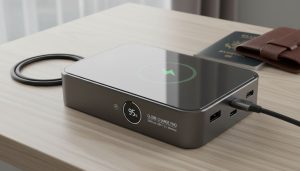
My Airport Security Routine
Security checkpoints can be a headache, especially when agents ask to inspect electronics. Over time, I’ve built a system:
- Keep portable batteries in my carry-on, never in checked luggage.
- Use cable ties or covers to keep ports clean.
- Place my device in the tray alongside my laptop for easy inspection.
- Avoid tossing coins or keys in the same pocket they can cause short circuits.
It sounds minor, but these habits cut down delays and keep my items safe.
Power Bank Features That Actually Matter on the Road
Not all packs are equal. The best models for travel have a few shared traits:
- Clear watt-hour labeling so security staff don’t hassle you.
- USB-C fast charging that works for both input and output.
- Multiple output ports to handle phones, earbuds, or a tablet at once.
- Compact design that fits easily in seat pockets or backpacks.
- Built-in cables or neat storage to reduce clutter.
- Safety protections against overheating or overcharging.
- Low-light indicators so you can check status mid-flight without disturbing others.
These details separate travel-friendly units from bulky desk-bound bricks.
Best Power Banks for 2025 (With Pros & Cons)

EcoFlow RAPID Pro (20,000 mAh, 230W, Built-in 100W Cable)
Pros: Compact, TSA-compliant, charges phones and light laptops quickly.
Cons: Higher price point.
Anker PowerCore 10000
Pros: Lightweight and pocket-sized, perfect for short trips.
Cons: Single device support, slower on tablets.
Zendure SuperMini
Pros: Sleek design, surprisingly powerful for its size.
Cons: Premium price for a smaller capacity.
Mophie Powerstation Plus
Pros: Integrated cables reduce clutter, reliable brand.
Cons: Slightly heavier than similar models.
RAVPower 20000
Pros: Affordable, sturdy, and reliable.
Cons: Not as fast as newer models with advanced USB-C support.
For a deeper dive, I’ve created a full guide on plane-safe power banks, covering both domestic and international carriers.
How I Match the Right Pack to Each Journey
For me, choosing the right device depends on the trip:
- Two days in Paris → I grab a slim, lightweight option that slips into my jacket.
- Cross-Atlantic flight → A 20,000 unit that can charge two phones plus a tablet.
- Work trips with heavy device use → I carry two mid-sized packs instead of one massive one.
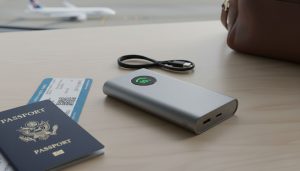
This strategy avoids problems at airline gates and ensures I always have backup energy.
Where to Store Your Pack
One of the most common mistakes I see travelers make is tossing their power bank into checked luggage. Big no. Airlines around the world have strict safety rules about this, and for good reason. These devices contain lithium cells, which can pose fire risks if damaged or exposed to extreme pressure in the cargo hold. That’s why the rule is simple: your pack always stays with you in the cabin.
So, where exactly should it go? Here’s what I’ve learned from countless flights:
Keep Your Power Bank in Your Carry-On
Your first option should always be your cabin bag. Place it in an easy-to-reach pocket so you don’t have to unpack half your suitcase when security officers ask to see the label. I usually keep mine alongside my laptop; it makes TSA checks faster since both items can be inspected together in one tray.
Move Your Power Bank if the Bag Is Gate-Checked
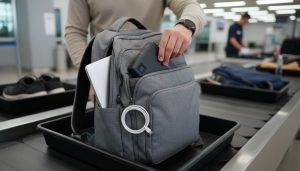
Sometimes airlines run out of overhead space and ask passengers to gate-check their carry-on. If this happens, remove your power bank immediately and put it into your personal item (like a backpack or handbag). Staff may even remind you at the gate, but it’s best not to rely on that. I once saw a traveler almost lose his pack because he forgot to take it out, and the ground crew had to call him back before loading the bag.
Store Your Power Bank Safely During the Flight
Once you’re on board, avoid tossing the unit into overhead bins where it could get squeezed by other luggage. Instead:
- Slide it into the seat pocket in front of you.
- Keep it in your backpack under the seat if you’re not using it.
- Use a soft case or pouch to protect the ports and prevent scratches from keys or coins.
If you’re charging during the flight, leave the device visible. Cabin crew prefer that batteries aren’t hidden under blankets or wedged into cushions, since overheating can be harder to spot.
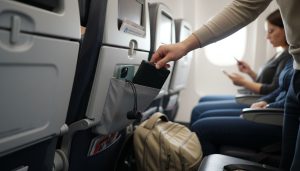
Why Power Banks Don’t Belong in Checked Baggage
The cargo hold is pressurized but not monitored the way the cabin is. If something goes wrong with a lithium pack down there, say, a thermal runaway or short circuit, there’s no way to address it quickly. In the cabin, however, the crew is trained to handle battery issues. That’s why regulators worldwide keep repeating the same rule: carry on only.
My Personal Routine
Here’s my personal system for keeping things smooth:
- Before leaving home, I put my pack in a slim power bank.
- I place it in the outer pocket of my backpack, next to my laptop.
- At security, I take both out at once, label facing up.
- If my carry-on has to be gate-checked, I quickly slip the unit into my smaller bag before handing the suitcase over.
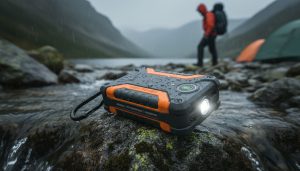
This way, I never risk losing it, and I save time at inspections.
Safety Habits Worth Following
- Keep sharp metal objects away from ports.
- Don’t wrap it in clothes while charging (heat build-up can be risky).
- Unplug if it feels unusually hot.
- Store cables neatly.
Simple precautions like these make travel smoother and safer.
How to Make Your Unit Last Longer
Think of it as an investment you want years of service, not months. Here’s what I do:
- Keep charge levels between 20% and 80% when possible.
- Store in a cool, dry place (avoid direct sunlight).
- Use high-quality charging cables to reduce wear.
- If unused for a while, give it a top-up every 4–6 weeks.
Common Questions Travelers Ask
What if my carry-on is gate-checked?
Take the battery out and keep it with you.
Can I bring a smart suitcase with a built-in battery?
Yes, but only if the cell is removable.
Is charging mid-flight safe?
Yes, though you should follow crew instructions and avoid covering the device.
Should I buy one large pack or two smaller ones?
Two smaller units usually work better for flexibility and backup.
How long do these devices usually last?
Quality models generally handle 300and500 charge cycles, about 3-5 years of regular use.
Final Thoughts
Choosing the right portable power bank solution isn’t about chasing the biggest number. It’s about finding a balance between power bank capacity, size, and airline approval. For most travelers, a mid-sized pack under 100 Wh with USB-C fast charging is the perfect balance.
For me, it’s more than a convenience; it’s a safety net. A well-chosen unit means no more last-minute outlet hunts, no more panic when the map app shuts off, and no more stress at airport security.
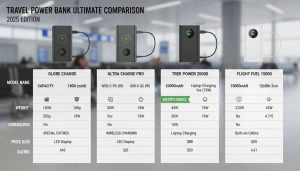
Before your next journey, take a moment to add one to your essentials list. You’ll thank yourself somewhere between the boarding gate and baggage claim.